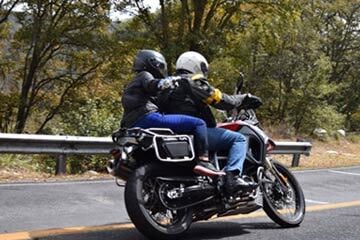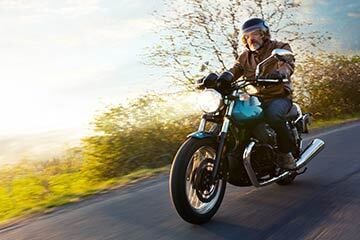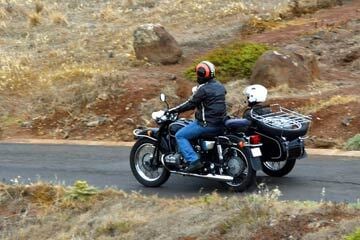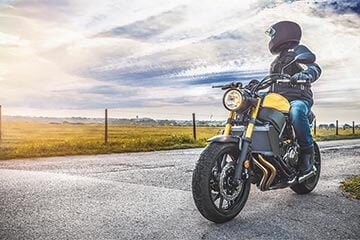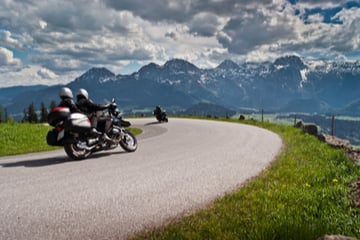The type of motorbike you ride affects how you're likely to use it as well as its performance.
And the style of your motorbike can also affect the cost of your motorbike insurance.
Here’s a rundown on the different motorcycle types, how to identify them and how they're commonly used.
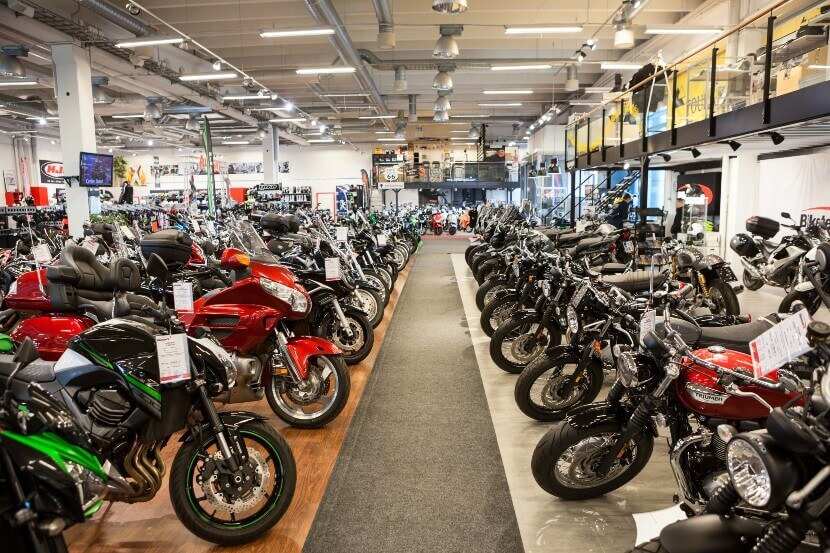
How do different types of motorbike impact my motorbike insurance costs?
The cost of motorbike insurance depends on several factors, not just the type of motorcycle you ride.
All motorbikes are put into categories by insurers and this directly relates to how much your costs could be.
But other important factors include:
- Your riding history
- Where you live
- Where you keep your motorbike
- How you use the motorbike
Do I need to know my motorbike type when I get insurance?
No. When you compare motorbike insurance with us, we'll ask you for:
- The motorbike registration - or its make and model
- Its value
- Whether it's an official UK model
Although we don't ask about what type of motorbike you have, it's useful to know anyway in case:
- You want to sell your motorbike and the buyer asks about its type
- You're looking to buy a new motorcycle for a different purpose
- You want to make sure your motorbike is suited to how you want to use it
Although we don't ask about what type of motorbike you have, it's useful to know anyway so:
- You can accurately describe the motorbike if you want to sell it
- You can make sure your motorbike suits your needs
- You can get a new motorbike for a different purpose
What are the different types of motorbike?
This list isn't exhaustive - here we look at the most common types of motorbike:
- Sport bikes
- Cruisers
- Touring bikes
- Standard bikes
- Naked bikes
- Dual sport / adventure bikes
- Off-road bikes
- Scooters / mopeds
Sport bikes
Sports bikes are built for power and speed. They have fast, powerful engines, sharp styling and handling, and aerodynamic fairings.
Examples of sports bikes include:
- Yamaha YZF-R125
- Ducati Panigale V4
- Kawasaki Ninja ZX-10R
Sport bikes are built for speed and have blistering acceleration. Depending on the engine size, novice riders might not have the right licence to ride a sport bike.
Common features of sport bikes include:
- Full fairing
- Forward-leaning riding position
- Angular bodywork to reduce wind resistance
Because sport bikes are designed for speed and performance, they're considered higher risk by insurers. This is likely to result in higher motorbike insurance costs.
Cruiser motorbikes
Cruisers prioritise comfort over anything else, allowing for more relaxed riding.
Some example of cruiser motorcycles include:
- Harley Davidson Fat Boy
- Kawasaki VN900
- Triumph Bonneville Bobber
One of the main features of cruise motorbikes is that they have large engines. The 2022 Harley Davidson Fat Boy, for example, has a 1868cc engine.
These larger engines mean there's a greater risk of an expensive claim if you had an accident. So cruisers tend to be in the higher end of motorbike insurance groups.
Cruiser motorbikes tend to have:
- A relaxed riding position
- Chunky bodywork
- Large tyres
Touring motorcycles
Designed for long distances, touring motorbikes are big, comfortable rides. These motorbikes are built for on-road comfort for both rider and pillion passengers.
Touring motorbikes include:
- Honda Gold Wing
- Harley-Davidson Road King
- Indian Roadmaster
Tourers tend to have:
- Large windscreens
- Generous luggage capacity
- Comfortable seating designed for rider and pillion passenger
Given their size, combined with their luggage and fuel capacity, it’s not surprising that tourers are among the heaviest bikes on the road.
To help with this, they often have features such as hill-start assist, and some have a reverse gear to help with parking.
If you're riding a tourer, it's worth considering adding pillion cover for any passengers. When you get a motorbike insurance quote, we'll ask you "Would you like to include pillion cover?". Adding cover for a passenger is likely to increase your insurance costs, though.
Standard motorbikes
Standard motorbikes aren't designed for any special use. As such, their performance, practicality and comfort have a wider range than some other motorbike types. Standard motorbikes are often a good choice for novice riders due to their versatility.
Examples of standard motorcycles include:
- Kawasaki Z900
- Yamaha MT-07
- KTM 200 Duke
Common features of standard motorcycles include:
- An upright seating position
- Little to no fairing
- Mid-range engine
Since standard motorbikes tend to have smaller engines than the likes of tourers and cruisers, they should be in a lower motorbike insurance group. Depending on your age and riding experience, they may be less expensive to insure.
Naked motorbikes
Naked motorbikes are unfaired sports bikes.
The term ‘naked’ refers to road bikes without a fairing to obscure the engine and frame, and normally no screen over the handlebars.
Removing the fairings makes the motorbike lighter, faster and more manoeuvrable.
- Triumph Street Triple
- Honda CB125R
- Kawasaki Z650
Naked motorbike often have:
- An exposed engine
- An upright seating position
- Higher handlebars
There's a wide range of engine sizes for naked motorbikes. The Triumph Street Triple is in insurance group 14, whereas the Honda CB125R is in insurance group 7.
Adventure motorbikes
Adventure motorbikes are designed to be endurance machines, with larger luggage compartments and petrol tanks for long-distance trekking.
And thanks to their dual-sport capability, they also often have the capability to do a bit of off-roading.
Adventure motorbikes include:
- BMW R1250GS
- Suzuki V-Strom 1000
- Triumph Tiger 800
Adventure motorbikes tend to have:
- Larger fuel tanks for long-distance travel
- Long-travel suspension
- A tall, upright seating position for greater visibility
Being bulky models with large engines, adventure motorbikes are likely to be more expensive to insure.
Off-road motorbikes
Off-road motorbikes have 3 common variations:
- Motocross: Built for off-road racing and have suspension designed for rough terrain and large jumps. They're rarely road legal and are only used for racing.
- Enduro: Used for long-distance time-trial competitions. They're heavier than motocross motorbikes and have extras – such as lights and a speedometer – to make them legal to drive on the road.
- Dirt bike: Lightweight, fast and powerful, with tyres that can cope with surfaces ranging from dirt roads to rocks.
Some examples of off-road motorcycles include:
- Honda CRF450R
- Yamaha WR450F
- KTM 250 XC-F
There are hundreds of styles and variations of off-road motorbikes. These range from enduro bikes that are used for long distance off-roading through to trials bikes that are so lightweight they don’t even have a seat.
Many types of off-road bikes can’t be used on the road at all. If you want to use yours on the road, you need to ensure it’s legal to do so first.
Off-road motorbikes tend to have:
- Knobby-thread tyres
- Long-travel suspension
- Higher ground clearance
Scooters and mopeds
Mopeds are small engine 50cc motorbikes with a top speed of about 28mph. This makes them legal for 16 year olds to ride on UK roads.
As mopeds have such low power, moped insurance tends to be much cheaper than for other types of motorbikes.
Scooters describe a low-power motorbike with a step-through frame. They tend to have larger engines than mopeds – normally 125cc-150cc – and normally have storage under the seat.
Some examples of mopeds and scooters include:
Mopeds
- Honda SuperCub
- Vespa Primavera
- Yamaha Jog
Scooters:
- Piaggio Vespa GTS 125
- Honda PCX 150
- Yamaha NMAX 125
The smaller engine reduces its running costs, making it more affordable than bigger motorbikes. It's small size and agility make it a good choice for inner-city commuters too.
Scooters and mopeds tend to have:
- A step-through design
- Automatic transmission
- Relatively small engine sizes
Scooter insurance is often considerably cheaper than other motorbike insurance too, since a lightweight machine is unlikely to cause much damage to other road users. Because of this, mopeds and scooters tend to be a popular choice for new riders.
Trikes and quads
While these aren't strictly motorbikes, they're usually included with them. But there are important differences when it comes to insuring trikes and quads.
Trikes
A motorised tricycle is a 3-wheeled vehicle with an open body and handlebars. Examples include:
- Harley-Davidson Tri Glide Ultra
- Rewaco RF1 series
- Boom Low Rider
When looking at your trike insurance options, make sure you're getting the right kind of policy for your ride. Some trikes are considered to be more like cars than motorbikes, so you'd need to get a car insurance policy for it.
Quads
A large 4-wheeled ride designed for off-roading and can be used for towing and farming. Some examples include:
- Honda FourTrax Rancher
- Yamaha Grizzly 700
- Can-Am Outlander 1000
You only need quad bike insurance if you plan on using it on a public road. You also have to make sure it's safe and legal to ride on a public road, including:
- Being 'type approved'
- Have valid MOT and tax


